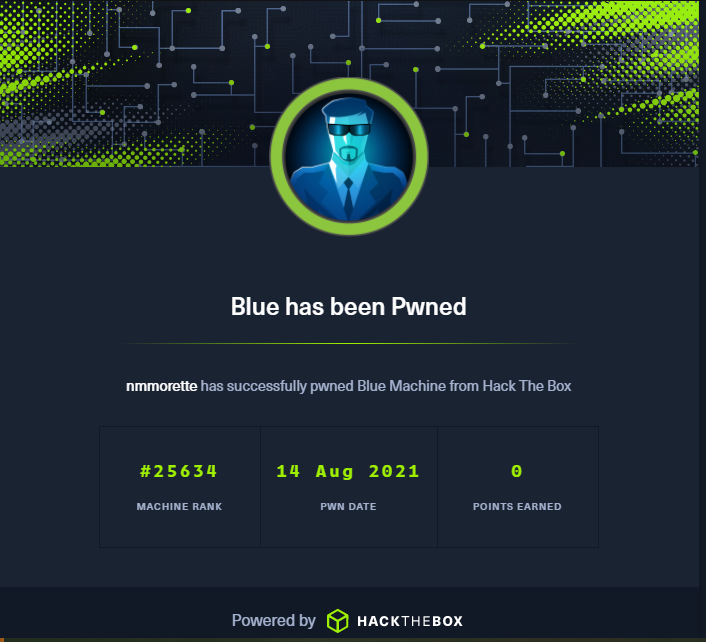3 minutes
Hack the Box - Blue- Write Up


Enumeration
Initial scan:
└──╼ $sudo nmap -sS -Pn 10.10.10.40
Host discovery disabled (-Pn). All addresses will be marked 'up' and scan times will be slower.
Starting Nmap 7.91 ( https://nmap.org ) at 2021-08-11 15:11 -03
Nmap scan report for 10.10.10.40
Host is up (0.45s latency).
Not shown: 991 closed ports
PORT STATE SERVICE
135/tcp open msrpc
139/tcp open netbios-ssn
445/tcp open microsoft-ds
49152/tcp open unknown
49153/tcp open unknown
49154/tcp open unknown
49155/tcp open unknown
49156/tcp open unknown
49157/tcp open unknown
Second nmap scan with --script vuln only on the open ports:
sudo nmap -sS -Pn 10.10.10.40 -A -p135,139,445,49152,49153,49154,49155,49156,49157 --script vuln
Host discovery disabled (-Pn). All addresses will be marked 'up' and scan times will be slower.
Starting Nmap 7.91 ( https://nmap.org ) at 2021-08-11 15:25 -03
Pre-scan script results:
| broadcast-avahi-dos:
| Discovered hosts:
| 224.0.0.251
| After NULL UDP avahi packet DoS (CVE-2011-1002).
|_ Hosts are all up (not vulnerable).
Nmap scan report for 10.10.10.40
Host is up (0.50s latency).
PORT STATE SERVICE VERSION
135/tcp open msrpc Microsoft Windows RPC
139/tcp open netbios-ssn Microsoft Windows netbios-ssn
445/tcp open microsoft-ds Microsoft Windows 7 - 10 microsoft-ds (workgroup: WORKGROUP)
49152/tcp open msrpc Microsoft Windows RPC
49153/tcp open msrpc Microsoft Windows RPC
49154/tcp open msrpc Microsoft Windows RPC
49155/tcp open msrpc Microsoft Windows RPC
49156/tcp open msrpc Microsoft Windows RPC
49157/tcp open msrpc Microsoft Windows RPC
Warning: OSScan results may be unreliable because we could not find at least 1 open and 1 closed port
Aggressive OS guesses: Microsoft Windows 7 or Windows Server 2008 R2 (97%), Microsoft Windows Home Server 2011 (Windows Server 2008 R2) (96%), Microsoft Windows Server 2008 SP1 (96%), Microsoft Windows Server 2008 SP2 (96%), Microsoft Windows 7 (96%), Microsoft Windows 7 SP0 - SP1 or Windows Server 2008 (96%), Microsoft Windows 7 SP0 - SP1, Windows Server 2008 SP1, Windows Server 2008 R2, Windows 8, or Windows 8.1 Update 1 (96%), Microsoft Windows 7 SP1 (96%), Microsoft Windows 7 Ultimate (96%), Microsoft Windows 7 Ultimate SP1 or Windows 8.1 Update 1 (96%)
No exact OS matches for host (test conditions non-ideal).
Network Distance: 2 hops
Service Info: Host: HARIS-PC; OS: Windows; CPE: cpe:/o:microsoft:windows
Host script results:
|_smb-vuln-ms10-054: false
|_smb-vuln-ms10-061: NT_STATUS_OBJECT_NAME_NOT_FOUND
| smb-vuln-ms17-010:
| VULNERABLE:
| Remote Code Execution vulnerability in Microsoft SMBv1 servers (ms17-010)
| State: VULNERABLE
| IDs: CVE:CVE-2017-0143
| Risk factor: HIGH
| A critical remote code execution vulnerability exists in Microsoft SMBv1
| servers (ms17-010).
|
| Disclosure date: 2017-03-14
| References:
| https://cve.mitre.org/cgi-bin/cvename.cgi?name=CVE-2017-0143
| https://technet.microsoft.com/en-us/library/security/ms17-010.aspx
|_ https://blogs.technet.microsoft.com/msrc/2017/05/12/customer-guidance-for-wannacrypt-attacks/
TRACEROUTE (using port 135/tcp)
HOP RTT ADDRESS
1 244.54 ms 10.10.16.1
2 445.61 ms 10.10.10.40
OS and Service detection performed. Please report any incorrect results at https://nmap.org/submit/ .
Nmap done: 1 IP address (1 host up) scanned in 130.01 seconds
The host is vulnerable to ms17-10:

Exploit
Let’s double-check this vuln with msfconsole.
Search for “ms17-010” and use the module: scanner/smb/smb_ms17_010:

We have the confirmation:

We need to set the exploit windows/smb/ms17_010_eternal and configure the options: RPORT, RHOSTS, LPORT and LHOST. Also, check the payload.

After that we could run the exploit and get access to the host:

Flag
Search for the flag in the commons users folders.
